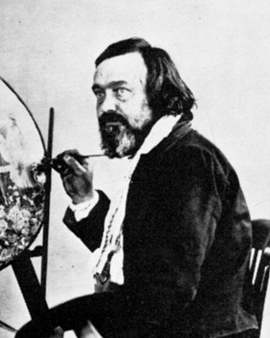In the 19th century, fairy, gnome and elf motifs developed into an independent genre. The mythical creatures appeared more and more often, both in the paintings of many artists and as motif in many exhibitions. A well-known representative of this genre was Richard Dadd, an English painter whose story began with the successful career of an artist and ended with schizophrenia.
His genres were: History, portraits and landscapes - but also elfin motifs. The latter already gained the interest of the public in his youth and were praised by many critics, which encouraged the development of this motif into an independent genre. It is speculated that the artist had already gained a special interest in the elf theme at the Royal Academy School, where he studied and thus had contact with professors who were familiar with such motifs. In 1838 Richard Dadd founded "The Clique", a group of painters whose main subject was academic painting. In this circle were artists like Augustus Egg, Alfred Elmore, John Phillip and others.
The development of his paintings goes hand in hand with the painter's mental state; while the earlier works are perceived as lighter, the later ones seem to have fallen into confusion (cf. "Tobsucht" with "Kommen Sie zu diesen gelben Sanden"), although there are different opinions as to how far the outbreak of the disease influenced Dadd's paintings. However, one thing is certain: the details in the paintings are painted in detail and thoughtfully.
Remarkable is the effect the paintings have. While earlier depictions of elves appear to be part of a fantasy world, Dadd's works "experiment" with the viewer's consciousness. The consciousness had to be separated from the real world and put into a kind of trance. Although the artist still painted during his stay in hospital, he gradually withdrew from the art world. Nevertheless, his works did not lose their importance and enjoyed attention at numerous exhibitions.
×





.jpg)
.jpg)
.jpg)
.jpg)
.jpg)
.jpg)
.jpg)
.jpg)
.jpg)
.jpg)
.jpg)
.jpg)
.jpg)
.jpg)
.jpg)
.jpg)
.jpg)
.jpg)
.jpg)
.jpg)
_-_(MeisterDrucke-1425341).jpg)
_-_(MeisterDrucke-1425341).jpg)
 - (MeisterDrucke-67296).jpg)
 - (MeisterDrucke-67296).jpg)
.jpg)
.jpg)
.jpg)
.jpg)
.jpg)
.jpg)
 - (MeisterDrucke-97218).jpg)
 - (MeisterDrucke-97218).jpg)
.jpg)
.jpg)
_-_(MeisterDrucke-1632053).jpg)
_-_(MeisterDrucke-1632053).jpg)
.jpg)
.jpg)
_-_(MeisterDrucke-1129724).jpg)
_-_(MeisterDrucke-1129724).jpg)
.jpg)
.jpg)
.jpg)
.jpg)
.jpg)
.jpg)
.jpg)
.jpg)
.jpg)
.jpg)
 - (MeisterDrucke-42081).jpg)
 - (MeisterDrucke-42081).jpg)
.jpg)
.jpg)
.jpg)
.jpg)
.jpg)
.jpg)
.jpg)
.jpg)
 - (MeisterDrucke-97558).jpg)
 - (MeisterDrucke-97558).jpg)
 - (MeisterDrucke-549148).jpg)
 - (MeisterDrucke-549148).jpg)
.jpg)
.jpg)
.jpg)
.jpg)
_-_(MeisterDrucke-69465).jpg)
_-_(MeisterDrucke-69465).jpg)
.jpg)
.jpg)
.jpg)
.jpg)
.jpg)
.jpg)
.jpg)
.jpg)
.jpg)
.jpg)
.jpg)
.jpg)
.jpg)
.jpg)
.jpg)
.jpg)
.jpg)
.jpg)
.jpg)
.jpg)
_-_(MeisterDrucke-998320).jpg)
_-_(MeisterDrucke-998320).jpg)
.jpg)
.jpg)
.jpg)
.jpg)
.jpg)
.jpg)
.jpg)
.jpg)
.jpg)
.jpg)
.jpg)
.jpg)
.jpg)
.jpg)
.jpg)
.jpg)
.jpg)
.jpg)
_-_(MeisterDrucke-908531).jpg)
_-_(MeisterDrucke-908531).jpg)
.jpg)
.jpg)
.jpg)
.jpg)
.jpg)
.jpg)
.jpg)
.jpg)
.jpg)
.jpg)
.jpg)
.jpg)
.jpg)
.jpg)
.jpg)
.jpg)
.jpg)
.jpg)
.jpg)
.jpg)
.jpg)
.jpg)
.jpg)
.jpg)
 - (MeisterDrucke-72746).jpg)
 - (MeisterDrucke-72746).jpg)
.jpg)
.jpg)
.jpg)
.jpg)
.jpg)
.jpg)
.jpg)
.jpg)
.jpg)
.jpg)
.jpg)
.jpg)
_-_(MeisterDrucke-291016).jpg)
_-_(MeisterDrucke-291016).jpg)
.jpg)
.jpg)
.jpg)
.jpg)
.jpg)
.jpg)
.jpg)
.jpg)
.jpg)
.jpg)
.jpg)
.jpg)
.jpg)
.jpg)
.jpg)
.jpg)
.jpg)
.jpg)
.jpg)
.jpg)




